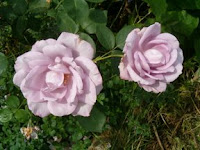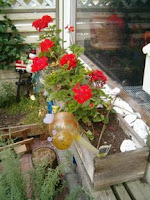






 Harvesting the Snow Peas, Oriental Lilly's Splash of Color
Harvesting the Snow Peas, Oriental Lilly's Splash of ColorSara’s Oriental Lily, “Stargazer,” put on quite the show this past week when the 16 to 20-inch spread of this super colorful bloom popped up in the middle of the main flowerbed.
It can bloom any time from June to September, amd does alright in full sun, as well as partial shade. It’s about three feet tall and fits in well with the Phlox, Black Eyed Susans, Daisies, and Anemone that inhabit its part of the patch.
It’s not only the look of this exotic flower, but also the fragrance that will capture your senses. Take a whiff of this beauty and you’ll be hopelessly in love with the Stargazer.
One word of warning, hovever. If you’re entertaining the idea of using Lilies as cut flowers (let’s say as a centre piece for a family dinner), make sure you clip the sepals before putting them on your best table cloth.
Lilies drop pollen on whatever they touch, and one of our lovely, green, Hungarian embroidered table cloths became a victim of their black, sticky dust, which leaves a stain that is impossible to remove.
Sara has been planting more Phlox in her flower garden. She chose delicate, pastel colored blooms (salmon pink, light purple, bluish purple), that serve as clever contrast to the bold, bright colored Lilies.
The bright yellow Pumpkin flowers have appeared en masse and we harvested our first batch of Snow Peas this week. We’ve already dropped them into salads—they’re tender and crunchy when young, and we’ve sautéed some with garlic for a special treat.
The Snow Peas took about 90 days to go from seed to harvest. I just poured the seeds into a pre-dug trench and they germinated in soil, around the second week of May. I recently planted some more Peas, hoping to harvest them before the cold spell hits in October-November.
As you know, we use Iguana Juice Grow for the veg stage of our plants, and Iguana Juice Bloom for the flowering stage. One thing we had to be careful of was planting Lettuce seeds too close to the Tomatoes and the Peas.
Tomatoes and Peas have to go into flower to produce fruit, while a wise gardener prevents Lettuce from flowering (or bolting). Lettuce on its way to producing seed tastes bitter.
So we had to continue fertilizing the Lettuce with Iguana Juice Grow, while a foot away we fed out Tomatoes and Snow Peas iguana Juice Bloom, to encourage flower formation. Some trick. Next year we’ll plant them further apart.
As if to belie my early obituary, our Rose bushes have come back in full force. The Purple Passion Rose featured a full bouquet of blooms this week, as did the Blue Girl Rose.
Given the history of Black Spot on some of our Roses (notably the generic Pink Rose) I spray them every week with Scorpion Juice, and the treatment seems to work very well. We also water with a nutrient mix featuring Barricade, and up until week 2 of bloom I sprayed with Protector, to keep Powdery Mildew away.
The Cecile Brunner Rose is producing a prolific quantity of small, delicate, cream-colored Rose buds, and even the Stainless Steel Hybrid Tea Rose has made a comeback after being slightly damaged by all the rain we had back in July.
Our bamboo bean house is fully covered with Scarlet Runner Beans and another variety. I keep meaning to ask Sara what the other bean is called that she planted, but I keep forgetting. I know that it’s smoother than the scarlet runner and is especially good in stir fries.
Some of the Gladiolas are flowering again, and the Anemone is blooming happily on top of the canopy. The soil is looking especially fertile, what with all the Humic Acid and Fulvic Acid we mix in to our watering solution.
We also use Organic B to relieve plant stress, as well as Seaweed Extract, which not only contains many kinds of vitamins, but also natural hormones and antibiotics. Kelp is also a good source of Iron, which helps keep our plants from getting anemic.
By finding the Nutrient Calculator on the upper, right hand corner of the AN website, fellow gardeners can set their own feeding regimen, after they choose between organic or synthetic.
The Calculator is flexible. Depending on the individual plants you grow, you can set the number of weeks you want it to veg, followed by the number of weeks in bloom. Just click on the Add Week or Remove Week buttons to do this.
There is another feature of the AN website which I find useful. You can locate the Advancedpedia on the home page, with technical details and product descriptions on the entire line of organic and synthetic ferts, additives, supplements, root colonizers, and bloom boosters made by Advanced Nutrients.
Sara’s flowers and my vegetables are proof that AN makes the best darn plant food in the universe, bar none.
It can bloom any time from June to September, amd does alright in full sun, as well as partial shade. It’s about three feet tall and fits in well with the Phlox, Black Eyed Susans, Daisies, and Anemone that inhabit its part of the patch.
It’s not only the look of this exotic flower, but also the fragrance that will capture your senses. Take a whiff of this beauty and you’ll be hopelessly in love with the Stargazer.
One word of warning, hovever. If you’re entertaining the idea of using Lilies as cut flowers (let’s say as a centre piece for a family dinner), make sure you clip the sepals before putting them on your best table cloth.
Lilies drop pollen on whatever they touch, and one of our lovely, green, Hungarian embroidered table cloths became a victim of their black, sticky dust, which leaves a stain that is impossible to remove.
Sara has been planting more Phlox in her flower garden. She chose delicate, pastel colored blooms (salmon pink, light purple, bluish purple), that serve as clever contrast to the bold, bright colored Lilies.
The bright yellow Pumpkin flowers have appeared en masse and we harvested our first batch of Snow Peas this week. We’ve already dropped them into salads—they’re tender and crunchy when young, and we’ve sautéed some with garlic for a special treat.
The Snow Peas took about 90 days to go from seed to harvest. I just poured the seeds into a pre-dug trench and they germinated in soil, around the second week of May. I recently planted some more Peas, hoping to harvest them before the cold spell hits in October-November.
As you know, we use Iguana Juice Grow for the veg stage of our plants, and Iguana Juice Bloom for the flowering stage. One thing we had to be careful of was planting Lettuce seeds too close to the Tomatoes and the Peas.
Tomatoes and Peas have to go into flower to produce fruit, while a wise gardener prevents Lettuce from flowering (or bolting). Lettuce on its way to producing seed tastes bitter.
So we had to continue fertilizing the Lettuce with Iguana Juice Grow, while a foot away we fed out Tomatoes and Snow Peas iguana Juice Bloom, to encourage flower formation. Some trick. Next year we’ll plant them further apart.
As if to belie my early obituary, our Rose bushes have come back in full force. The Purple Passion Rose featured a full bouquet of blooms this week, as did the Blue Girl Rose.
Given the history of Black Spot on some of our Roses (notably the generic Pink Rose) I spray them every week with Scorpion Juice, and the treatment seems to work very well. We also water with a nutrient mix featuring Barricade, and up until week 2 of bloom I sprayed with Protector, to keep Powdery Mildew away.
The Cecile Brunner Rose is producing a prolific quantity of small, delicate, cream-colored Rose buds, and even the Stainless Steel Hybrid Tea Rose has made a comeback after being slightly damaged by all the rain we had back in July.
Our bamboo bean house is fully covered with Scarlet Runner Beans and another variety. I keep meaning to ask Sara what the other bean is called that she planted, but I keep forgetting. I know that it’s smoother than the scarlet runner and is especially good in stir fries.
Some of the Gladiolas are flowering again, and the Anemone is blooming happily on top of the canopy. The soil is looking especially fertile, what with all the Humic Acid and Fulvic Acid we mix in to our watering solution.
We also use Organic B to relieve plant stress, as well as Seaweed Extract, which not only contains many kinds of vitamins, but also natural hormones and antibiotics. Kelp is also a good source of Iron, which helps keep our plants from getting anemic.
By finding the Nutrient Calculator on the upper, right hand corner of the AN website, fellow gardeners can set their own feeding regimen, after they choose between organic or synthetic.
The Calculator is flexible. Depending on the individual plants you grow, you can set the number of weeks you want it to veg, followed by the number of weeks in bloom. Just click on the Add Week or Remove Week buttons to do this.
There is another feature of the AN website which I find useful. You can locate the Advancedpedia on the home page, with technical details and product descriptions on the entire line of organic and synthetic ferts, additives, supplements, root colonizers, and bloom boosters made by Advanced Nutrients.
Sara’s flowers and my vegetables are proof that AN makes the best darn plant food in the universe, bar none.
posted by Tim at
8:31 AM
![]()

0 Comments:
Post a Comment
<< Home